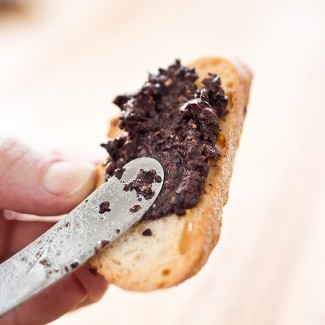Black Olive Tapenade

Most olive tapenade recipes include every ingredient but the kitchen sink and lack balanced olive flavor. For the best olive character, we use a ratio of 3 parts bright, fruity, water- or brine-cured olives to 1 part earthy, rich, salt-cured olives. To ensure that the olives take center stage, we use a judicious hand with supporting ingredients like capers, anchovies, garlic, mustard, and olive oil. Finally, to temper saltiness and provide a creamy texture, we incorporate a quick homemade butter of untoasted pine nuts. Our tapenade works equally well as a spread for crusty bread or as a dressing for pasta, boiled potatoes, or salad greens.
The tapenade must be refrigerated for at least 18 hours before serving. It’s important to use untoasted pine nuts in this recipe so that they provide creaminess but little flavor of their own. We prefer the rich flavor of kalamata olives, but any high-quality brine-cured black olive, such as niçoise, Sicilian, or Greek, can be substituted. Do not substitute brine-cured olives for the salt-cured olives. Serve the tapenade as a spread with sliced crusty bread or as a dip with raw vegetables.
⅓ cup pine nuts
1 ½ cups pitted kalamata olives
½ cup pitted salt-cured black olives
3 tablespoons capers, rinsed
2 anchovy fillets, rinsed and patted dry
2 teaspoons Dijon mustard
½ garlic clove, minced
¼ cup extra-virgin olive oil
1. In food processor fitted with metal blade, process pine nuts until reduced to paste that clings to walls and avoids blade, about 20 seconds. Scrape down bowl to redistribute paste and process until paste again clings to walls and avoids blade, about 5 seconds. Repeat scraping and processing once more (pine nuts should form mostly smooth, tahini-like paste).
2. Scrape down bowl to redistribute paste and add olives, capers, anchovies, mustard, and garlic. Pulse until finely chopped, about 15 pulses, scraping down bowl halfway through pulsing. Transfer mixture to medium bowl and stir in oil until well combined.
3. Transfer to container, cover, and refrigerate for at least 18 hours or up to 2 weeks. Bring to room temperature and stir thoroughly before serving.
TECHNIQUES
A Nutty Solution to Saltiness
Given that tapenade is built on olives, capers, and anchovies, it can be tricky to keep the spread’s saltiness in check. We adjusted ingredient ratios and rinsed away excess salt before we found our real fix in an Italian pesto–inspired trick: grinding pine nuts into paste. The mild-flavored (untoasted) nuts, which, like the other tapenade ingredients, are a staple in Mediterranean cuisine, temper the saltiness without adding much distracting flavor of their own.
PILE OF PINE NUTS: Adding pine nuts (ground first) to the tapenade tames its saltiness.
Tapping into Two Kinds of Olives
The two common olive-curing methods affect the flavor of the fruit (and our tapenade) very differently.
THREE TO ONE: For a balanced tapenade, we use a 3:1 ratio of punchy brine-cured olives to the richer salt-cured kind.
BRINE-CURED: TANGY
Brine-cured black olives (made with mature fruit) undergo natural fermentation over a period of months in a strong salt brine, much like naturally fermented pickles. During fermentation, sugars in the fruit convert into acetic and lactic acid, providing the characteristic sour flavor.
SALT-CURED: EARTHY
Salt-cured black olives (often misleadingly labeled oil-cured) are packed in salt when fully ripe, left to dehydrate and soften over a month or two, and then briefly plumped in oil. The intensely flavored results have soft flesh, little acidity, and a good bit of their original bitterness.
None Available.